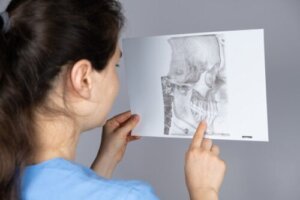What is Mandibular Retrognathia and How Is It Treated?

Mandibular retrognathia is a common dental and facial deformity. The word retrognathia comes from the Latin retro, which means ‘backward’; and from the Greek gnathos, which is ‘jaw’. In other words, it consists of a misalignment between the mandible and the maxillary bone.
In most cases, the cause is that the mandibular bone doesn’t develop properly. As a result, the jaw is positioned posteriorly and further back than normal. Thus, when looking at the profile of the affected person, the altered position can be easily seen.
The problem with this malformation is that it not only affects aesthetics, but can also lead to a series of dental and health complications. Do you want to know more about it? In this article, we’ll tell you what it is, its possible causes, and what treatments are available to address it.
What is mandibular retrognathia?
Mandibular retrognathia is a bone malformation. What happens is that there’s a discrepancy between the size of the maxillary bone and the mandibular bone. Therefore, they are misaligned with each other.
The significance of this is that the rows of teeth also don’t fit together. The jaw is ‘set back’ with respect to the maxilla. According to an article from Everest Dental Clinic, this is one of the types of dental malocclusion that tends to cause problems in the bite and facial aesthetics.
It can appear because the maxilla is developed more than normal or, on the contrary, because the jaw is underdeveloped. It can even be a combination of both factors. When looking at a person with retrognathia in profile, the lower face has a concave shape.
It’s also known as class II or short jaw relationship.
Like this article? You may also like to read: Five Home Remedies to Soothe Jaw Pain
Symptoms associated with this condition
Mandibular retrognathia has a significant aesthetic impact. As a publication of the Maxillofacial Institute explains, there’s an abnormal relationship between the maxillary and mandibular bone. This causes facial features to be disharmonious.
The upper dentition protrudes above the lower teeth and the mandible. Thus, when looking at that person in profile, the chin is sunken and there is no jaw projection. This can lead to problems with self-esteem and confidence.
Among other things, affected individuals often have difficulty chewing and dental problems. Similarly, there’s often involvement of the temporomandibular joint, as will be explained later.
What causes mandibular retrognathia?
This condition usually begins during development or growth. However, it can occur at any time in life, although this is somewhat less common. To understand why it occurs, it’s important to understand how the jaw normally develops.
As explained in a publication at StatPearls explains, the jaw bone begins to ossify during the sixth week of gestation . The condyle of the jaw is the part that articulates with the skull, through the temporomandibular joint. It develops later, around ten weeks of gestation.
Progressively, the mandible grows forward and downward, while the condyle also forms. Full development is usually reached around 17 or 18 years of age in females. In males, it can reach 20 years of age.
In people who have mandibular retrognathia, what happens is that this growth usually stops much earlier. As a result, the mandible is displaced backward and fails to align with the maxilla. It can also happen that the maxillary bone develops faster than normal.
When it appears in adult life, it’s due to different reasons. A severe injury to the jaw or temporomandibular joint can restrict growth. It can also happen when surgeries are performed at the cranial level.
Possible complications
This condition can cause serious complications, beyond aesthetic problems. For example, some babies begin to experience problems from birth.
This is because the misalignment between the two bones can make them unable to suck adequately on the mother’s nipple. As a result, feeding becomes difficult and malnutrition problems arise.
On the other hand, the fact that the two bones do not fit together properly means that the dental rows do not fit together either. Alignment of the teeth allows chewing and grinding of food.
Therefore, when this occurs, it can be difficult to bite and chew.
In addition, as you get older, your teeth tend to become more crooked or shifted. People with mandibular retrognathia often have temporomandibular joint disorders. The accumulated tension in the jaw and joint causes muscle spasms and severe jaw and head pain.
Another common complication is obstructive sleep apnea – that is, breathing problems appear during sleep, which may even lead to episodes of cessation of breathing at night. These episodes cause the person to sleep poorly and be drowsy during the day.
We think you may be interested in reading this, too: Jaw Pain Due to Stress: How to Deal With It
Treatments available for mandibular retrognathia
Mandibular retrognathia usually requires treatment. In order to institute treatment, it’s first important to arrive at a proper diagnosis. In many people, a physical examination is usually sufficient. However, additional tests are often performed to confirm the diagnosis.
Radiography is essential. The most commonly used is the lateral cephalometric radiograph. With this technique, it’s possible to make an analysis of the skull and its complete dimensions, to check if the jaw is less developed than normal. The angle, length, and relationship with the rest of the facial skeleton are also studied.
Once the study is done, treatment can be planned if necessary. If the case is mild and not very symptomatic, it isn’t always necessary to treat it. However, in the following sections, we’ll explain which options are most commonly used.
Treatment in infants and children
Treatment of retrognathia in infants and children is usually based on the use of orthodontics. The idea is that they are still growing. Therefore, an attempt can be made to slow down the growth of the jaw. This is done by using a kind of headgear that puts pressure on it.
The reason is that there is no way to stimulate jaw growth as such. Orthodontics can have very good results in mild to moderate cases. However, severe cases usually require further treatment in adolescence or adulthood.
Treatment in adolescents and adults
When growth has already slowed down, it’s very difficult to modify mandibular retrognathia with orthodontics alone. This technique can be useful when the problem is purely dental. That is, it only seeks to correct the alignment or occlusion of the teeth, but not the shape of the jaw.
There are patients who wish to correct their features – for example, having a deep chin or a receding chin. In these cases, if the dental problem has already been corrected, a mentoplasty may be recommended.
Severe cases associated with problems such as sleep apnea usually require surgery. This consists of intervening on the maxillary bone, or on the mandibular and maxillary bone. The idea is to try to reconstruct them to achieve an exact alignment.
Remember: Mandibular retrognathia is not only an aesthetic issue
Mandibular retrognathia is a problem that causes the mandible to be in an abnormal position, it’s located further back than normal. Therefore, the profile of these people shows a sunken chin and a concave shape.
The problem is that this condition can produce complications beyond aesthetics. For example, it’s associated with temporomandibular joint disorders and obstructive sleep apnea. It’s therefore essential to try to diagnose and treat this condition as soon as possible.
All cited sources were thoroughly reviewed by our team to ensure their quality, reliability, currency, and validity. The bibliography of this article was considered reliable and of academic or scientific accuracy.
- A Beginners Guide to Lateral Cephalometric Radiographs. (2015). Dental Protection. https://www.dentalprotection.org/uk/articles/a-beginners-guide-to-lateral-cephalometric-radiographs
- Clase II o Retrognatia Mandibular» Cirugía Ortognática – Instituto Maxilofacial. (2021, 1 marzo). Instituto Maxilofacial. https://www.institutomaxilofacial.com/es/tratamiento/cirugia-ortognatica-retrognatia-mandibular-clase-2/#:~:text=La%20retrognatia%2C%20del%20lat%C3%ADn%20retro,hacia%20la%20parte%20posterior%20de
- Harris, W. C. (2022, 1 mayo). Facial Chin Augmentation. StatPearls – NCBI Bookshelf. https://www.ncbi.nlm.nih.gov/books/NBK554506/
- Jenzer, A. C. (2023, 20 enero). Retrognathia. StatPearls – NCBI Bookshelf. https://www.ncbi.nlm.nih.gov/books/NBK538303/
- VAsquez, C., & VAsquez, C. (2022). Mandíbula retraída o retrognatismo. Clínica Dental Everest. https://clinicaeverest.cl/mandibula-retraida-o-retrognatismo-causas-y-tratamientos/
- Sanz-Cortes, M., Gómez, O., & Puerto, B. (2018). Micrognathia and Retrognathia. En Obstetric Imaging: Fetal Diagnosis and Care (Second Edition). https://doi.org/10.1016/b978-0-323-44548-1.00068-1
This text is provided for informational purposes only and does not replace consultation with a professional. If in doubt, consult your specialist.









